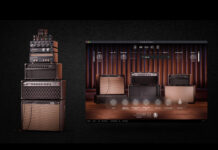
Tech Talk: Jazzmaster tuner trouble
I’ll tell you what, tuner trouble is bringing in the big bucks this summer. From my recent column on the Trini Lopez with the rough hewn shafts, to today’s subject, it’s been one after the other. I’m grateful for the work, but as the saying goes, when it rains it pours.
Recently my friend Brenden reached out with a very special 2015 Fender Jazzmaster in Shoreline Gold, one of the most alluring and rare custom colours. This instrument happens to be even more rare than simply colour alone: it’s a product of Fender’s American Design Experience, which began in 2011 as a visitor’s centre mainstay for guitar fans on a pilgrimage to the Fender factory in Corona.
The 2015 American Design Experience Jazzmaster in Shoreline Gold. It’s really a lovely guitarVisitors could hand-select bodies and necks, spec out their dream guitars, and have them built and shipped to their home in a matter of 90 days, which is a way more exciting souvenir than a personalised license plate keychain or a coffee mug. What better way to remember your trip to California than your dream guitar showing up at your door?
In 2014, this program was expanded to the non-nomadic masses via a portal on fender.com, and since then it’s turned into the Mod Shop, albeit with fewer features. Brenden made his order before that, though, and because he was able to specifically customise it, the guitar he ended up with is one of the lightest Jazzmasters I’ve ever held, and it also has the biggest neck I’ve ever seen on a stock Fender. Beautiful wood, don’t get me wrong, but with my predilection for slim necks, it’s a case of ‘nice place to visit, but I wouldn’t want to live there.’
The tuners were barely serviceable, but it wasn’t simply a case of mechanical failureThe guitar came to me for one of my famous offset setups, which I was more than happy to oblige. But there was a secondary issue of serious tuner slippage to address. As one rotates the tuner buttons, the shafts are meant to turn, or at least they should. In this case, it took nearly a full turn to see any response from the tuner shafts, which made tuning problematic, to say the least.
My first thought was, “These tuners are bad and should be replaced,” and while I was essentially correct, I wasn’t seeing the whole picture.
When I tried to remove the tuners, they were stuck firmly in place. It took considerable effort to get the high E machine out this farA little background: Brenden ordered this guitar in 2015, and the neck plate bears not only the date but also his name – again, a really great souvenir! Yet through various life circumstances, this guitar actually never saw any real playing time until, well, probably a month ago.
For five whole years it sat in its case in an unregulated environment, going through many cycles of heat and humidity changes. The guitar held up remarkably well considering, and the metallic finish still looks brand new. The rosewood fretboard, however, was one of the driest I’ve ever encountered. Fret sprouting was a symptom of the bone-dry board, as was the pale hue of the wood itself, more of a tan-and-red affair than the deep chocolate brown one might hope for.
1 of 2
This is the first time I’ve ever seen a headstock hold the tuners so firmly
Even having the tuners out this far gave me a good idea of what the true problem was
After a few lemon oil treatments and few days with a damp sponge in the case, the fretboard not only looked and felt better, but those sharp fret ends disappeared almost entirely. The importance of proper humidity cannot be overstated!
I performed my usual due diligence during the setup, checking electronics and slotting the nut properly, adding a shim as you do with Jazzmasters to increase break angle over the bridge, and I even installed a Mastery as well. But those tuners were last on my list, the final issue left untouched.
1 of 2
To widen the holes, I gently drilled them out to 1/4”
…and then to 17/32”
Off the peghead
I removed the mounting screws from these Fender-stamped Kluson-style tuners and tried to extract the high E tuner for inspection. I pulled… and pulled… and pulled. I scratched my head, wondering if I’d somehow missed a screw. Nope, all accounted for on my workbench. So, I pulled once more.
This tuner was not budging, it didn’t matter how hard I pulled. I tried the B, the G, even the A. All the same! Eventually I had to use a wooden block situated on the tips of the tuner shafts themselves to get enough surface area to allow me to push them out, at great effort. Thankfully, they moved – but only part of the way.
1 of 2
After drilling, the tuners slid right into place without catching
After finishing the setup, this one played like a dream…
In all of my years as a guitar tech, I have never seen a set of tuners stuck in a Fender headstock. “This is wild,” I thought to myself.
At this point I was able to finally free the tuners from the headstock, and this is where the real issue became clear. Remember when I mentioned that the guitar had been through many heat and humidity cycles, and that the fretboard had dried out?
1 of 2
…except for that huge neck!
Shoreline Gold is one of the most alluring custom colours in the Fender catalogue
It seems that through these environmental changes, the maple of the neck had contracted so drastically that the holes drilled in the headstock had seized around the tuner shafts themselves, gripping them so tightly that they could no longer be easily turned. This is why it took a revolution or two of the key to force them into motion.
At this point in the guitar’s life it didn’t seem feasible that any amount of added humidification would help, so I elected to drill out the headstock to the proper size for the shafts. The tuner shafts measure 6mm or 15/32”, and the headstock holes had closed up right around them. I first gently widened the hole to 1/4” followed up by a 17/32 bit to free up more space.
Six perfectly functional tuners. A job well doneSadly, because the tuners had been used with the headstock gripping them so tightly, the internal gears were too damaged to salvage. Even with the extra breathing room, they no longer engaged when turned. Luckily, Brenden provided another set of Gotohs that fit and operated perfectly.
Upon collection I counselled him to keep an eye on humidity with this one, but let him know that we were mostly out of danger at this point. I’m confident the repair will hold up over time, and at the end of the job that guitar turned out to be one hell of a good instrument – even if the neck was far too much of a baseball bat for my medium-sized hands.
Follow Mike on Instagram @puisheen.
The post Tech Talk: Jazzmaster tuner trouble appeared first on Guitar.com | All Things Guitar.
Source: www.guitar-bass.net












